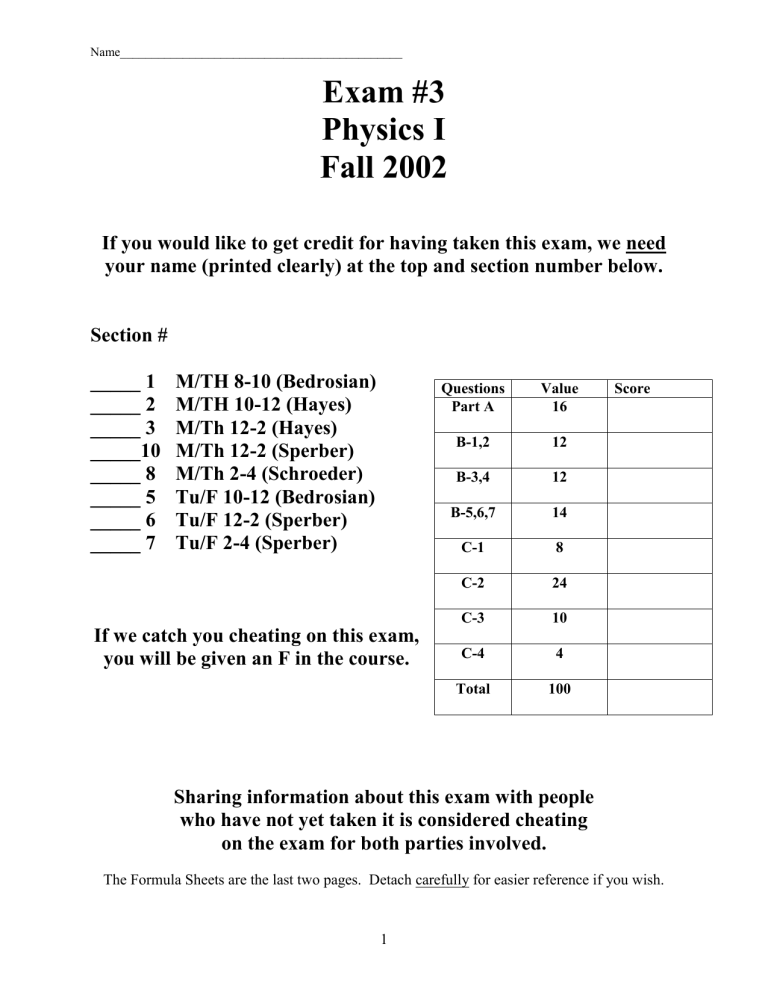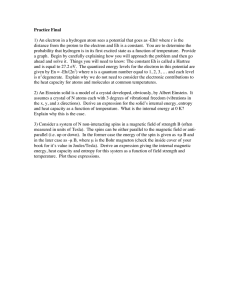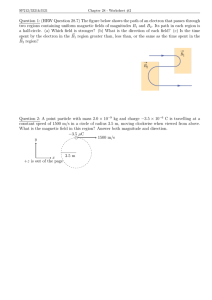exam3-F02.doc

Name_____________________________________________
Exam #3
Physics I
Fall 2002
If you would like to get credit for having taken this exam, we need your name (printed clearly) at the top and section number below.
Section #
_____ 1 M/TH 8-10 (Bedrosian)
_____ 2 M/TH 10-12 (Hayes)
_____ 3 M/Th 12-2 (Hayes)
_____10 M/Th 12-2 (Sperber)
_____ 8 M/Th 2-4 (Schroeder)
_____ 5 Tu/F 10-12 (Bedrosian)
_____ 6 Tu/F 12-2 (Sperber)
_____ 7 Tu/F 2-4 (Sperber)
If we catch you cheating on this exam, you will be given an F in the course.
Questions
Part A
B-1,2
B-3,4
B-5,6,7
C-1
C-2
C-3
C-4
Total
Value
16
12
12
14
8
24
10
4
100
Score
Sharing information about this exam with people who have not yet taken it is considered cheating on the exam for both parties involved.
The Formula Sheets are the last two pages. Detach carefully for easier reference if you wish.
1
Name_____________________________________________
On this exam, please neglect any relativistic and/or quantum mechanical effects. If you don’t know what those are, don’t worry, we are neglecting them! On all multiple choice questions, choose the best answer in the context of what we have learned in Physics I. On numerical questions, show all work to receive credit.
Part A – Warm-Ups – 16 Points Total (4 at 4 Points Each)
Write your choice on the line to the left of the question number.
_______ 1. A non-magnetic particle is moving in a uniform magnetic field. Which of the following conditions (if any) would lead to zero magnetic force on the particle?
A) The particle has zero electric charge.
B) The velocity of the particle is in the same direction as the magnetic field.
C) The velocity of the particle is in the opposite direction as the magnetic field.
D) Any of the above (A-C) would result in zero magnetic force on the particle.
E) None of the above; if the particle is moving in a magnetic field, there will be a force.
_______ 2. A charged, non-magnetic particle is moving in a uniform magnetic field. Which of the following conditions (if any) would cause the particle to speed up ?
A) The velocity of the particle is at a right angle to the magnetic field.
B) The velocity of the particle is in the same direction as the magnetic field.
C) The velocity of the particle is in the opposite direction as the magnetic field.
D) Any of the above (A-C) would cause the particle to speed up.
E) None of the above; the magnetic force cannot cause the particle to speed up.
_______ 3. The figure below shows equipotential lines in a certain region of space. What is the direction of the electric field in this region?
A) –X Y
B) +X
C) –Y
X
D) +Y
E) Cannot be determined.
V = 0
X = 0 cm
V = 50
X = 2 cm
V = 100
X = 4 cm
_______ 4. A proton moves in a circle of radius R at speed v in a magnetic field of strength B.
If we want an alpha particle (2 neutrons + 2 protons) to move in a circle of the same radius in the same magnetic field, what speed should it have? For this question, assume that the mass of an alpha particle is exactly four times the mass of a proton.
A) v/4.
B) v/2.
C) v.
D) 2 v.
E) 4 v.
2
Name_____________________________________________
Part B – Short Problems – 38 Points Total (5 at 6 Pts. + 2 at 4 Pts.)
Show all work.
B-1 (6 Points)
Calculate the acceleration due to gravity at the surface of the planet Mars. Assume Mars is a perfect sphere and neglect effects due to rotation. Use M = 6 .
4
10
23 kg and R = 3 .
4
10
6 m.
Answer: _____________________ units ________
B-2 (6 Points)
An electron begins at point A with a kinetic energy of 10,000 eV. The electric potential at point
A is 1,000 V. The electron moves to point B where the electric potential is 0 V. If the only force on the electron is due to the electric field, what is the kinetic energy of the electron at point B?
Answer: _____________________ units ________
3
Name_____________________________________________
B-3 (6 Points)
An electron is traveling in a vacuum tube at 1 .
4
10
7 m/s in a horizontal direction toward the south. There is a constant magnetic field in the tube with a magnitude of 0.5 gauss. The direction of the magnetic field is toward the north and 30º down (toward the ground). What is the magnitude of the magnetic (Lorentz) force on the electron? (1 T = 10,000 gauss.)
Up
30° v S N
-e
B
Down
Answer: _____________________ units ________
B-4 (6 Points)
In order to keep the electron in B-3 from accelerating out of its intended path, a uniform electric field is applied in the proper direction so that if it is correctly adjusted, the electric force on the electron exactly cancels the magnetic force. What is the magnitude of the electric field required?
(Guess a non-zero answer for B-3 if you don’t know how to calculate it and use that here.)
Answer: _____________________ units ________
4
Name_____________________________________________
B-5 (6 Points)
The electric field in B-4 is created by adjusting an electric potential difference between two parallel plates that are 5.0 cm apart (d). (The plates are equipotential surfaces.) What is the magnitude of the potential difference needed to get the electric field value you calculated in B-4?
(Guess a non-zero answer for B-4 if you don’t know how to calculate it and use that here.)
(E in the diagram above does not necessarily point in the “Up” direction.)
Answer: _____________________ units ________
Follow-Up Multiple Choice Questions (2 at 4 Points Each):
Write your choice on the line to the left of the question number.
______ B-6. In B-3, what is the direction of the magnetic force on the electron? Note that east
(E) is out of the page and west (W) is into the page.
A) North.
B) South.
C) East.
D) West.
E) Up.
F) Down.
______ B-7. In B-4, what is the direction of the electric field needed to counteract the magnetic force?
A) North.
B) South.
C) East.
D) West.
E) Up.
F) Down.
5
E
0 :
Name_____________________________________________
Part C – Extended Problem
This section contains numerical problems and one follow-up multiple-choice question.
C-1 (8 points)
A helium nucleus consisting of two neutrons and two protons is located at the center of the coordinate system shown below. An electron is located at X = 6.0 x 10
–11
m and Y = 0. Find the
X and Y coordinates of a location (not infinity) where the electric field created by the nucleus and electron is zero.
Y
X
+2e -e
6.0 x 10
–11
m
X Coordinate: _________________________ units ________
Y Coordinate: _________________________ units ________
6
Name_____________________________________________
C-2 (24 points)
Calculate the electric field and electric potential at point A (“X marks the spot”). Assume that the electric potential is zero at infinity.
Y
A
6.0 x 10
–11
m
X
Point A:
+2e
6.0 x 10
–11
m
-e
E field X Component: ___________________ units ________
E field Y Component: ___________________ units ________
Electric Potential: ___________________ units ________
7
Name_____________________________________________
C-3 (10 points)
Calculate the electric potential energy of the charge configuration in C-1, assuming the electric potential energy is zero when the nucleus and electron are infinitely far apart.
Electric potential energy: ___________________ units ________
Follow-Up Multiple Choice Question (1 at 4 Points):
Write your choice on the line to the left of the question number.
______ C-4. Let the electric potential energy of the configuration in C-1 be U
2
. (You calculated this in C-3.) Suppose we add an additional electron to the system at point A, so that the system now consists of one helium nucleus at X = 0 and Y = 0, the first electron at X = 6.0 x 10
–11
m and Y = 0, and the second electron at X = 0 and Y = 6.0 x 10
–11
A) U
3
< U
2
.
B) U
3
= U
2
.
C) U
3
> U
2
. m. Let the electric potential energy of the new configuration (helium nucleus plus two electrons) be U
3
. Which mathematical expression below is true? (Hint: You should not need to do the calculation of U
3
to get the answer.)
Y
-e A
6.0 x 10
–11
m
X
+2e
6.0 x 10
–11
m
-e
8
Name_____________________________________________
1.
2.
3.
4.
5.
6.
7.
8.
9.
10.
11.
12.
13.
14.
15.
16.
17.
18.
19.
20. v x x
v
0 x
0 x
0
Formula Sheet for Exam 3 and Final – Page 1 of 2
a
t
t
0
v
0
( t
1
2
( v
0
t
0
)
1
2 a ( t
v )( t
t
0
)
t
0
)
2
t
0
)
2
21.
22.
23.
24.
K
1 m v
2 1 m
2 2
K
U
U f g
K
m
i
F cons g (
W net
d x y
y
0
( v x
2
) x
x
0 v
2
F v
2
0
2
T
v ( t
F net
2 a
x
m t x
a
)
0
0
v r
1
2 a ( t
25.
26.
27.
28.
U
s
K
1
2
k (
U x
x
0
)
2
W non
cons s
r v tangential
r
v y
2
)
29.
30. a tangential
0
r
t
t
0
v
2 a centripeta l
2 r r
F centripeta l
p
P
J d d
t
P
F
m
F
v
F net dt
d
d
p t
p
p
i
F m ext v r
2
M
m i m
2 r x
P
a cm
b
W
W
M
1
F
F
a
d
d x m i x
M
v cm
b cos(
) i y cm
a x b x
1
M
a y b y m i y i
31.
32.
33.
34.
35.
36.
37.
38.
39.
40.
41.
42.
43.
I
0
2
a
b
0
2
0
a
(
b t
2
t sin(
0
)
)
0
1
2
( t
t
0
)
2
0
0
( t
m i
1
2
(
0 r i
2
t
0
)
K
W rot
r
1
I
2
F
d
2
l
L
L
I
r
I l
p i
d
L d t
1
2
( t
)( t
t
0
)
t
0
)
2
44x.
44y.
45a.
45b. m
1 v
1 , x , before m
1 v
1 , y , before v v
1 , f
2 , f
m m m
1
1
1
m
2 v
2 , x , before
m
2 v
2 , y , before m
2 m
2
2 m
1
m
2 v v
1 , i
1 , i
m
1 v
1 , x , after m
1 v
1 , y , after m
1 m
2 m
2
m
2
2
m
1 m
1
m
2 v v
2 , i
2 , i
m
2 v
2 , x , after
m
2 v
2 , y , after
9
Name_____________________________________________
46.
47.
48.
49.
50.
F
F
E
F
V
G m
1 r
2 m
2
Formula Sheet for Exam 3 and Final – Page 2 of 2 rˆ
52. V
E
d x
1
4
0
q
E
1
4
0
1
4
0
U
q V q
1 r
2 q
2 q i r i q i r i
2 rˆ rˆ i
53x.
53y.
54.
55.
E x
d V d x
F
E y
q
v
d V
d
y
B r
m v q B
51.
Useful Constants
(You can use the approximate values on tests.)
Universal Gravitation Constant G
6 .
673
10
11
N m
2 kg
2
6 .
67
10
11
Electrostatic Force Constant
Magnetic Constant
Speed of Light in Vacuum
Charge of a Proton
Electron-Volt Conversion Constant
Mass of a Proton
1
4
0
8 .
987551788
10
9
N m
2
C
2
9 .
0
10
9
0
4
10
7
H m
1
1 .
26
10
6 c
2 .
99792458
10
8 m s
1
3 .
0
10
8 e
1 .
602176462
10
19
C
1 .
6
10
19
1 e V
1 .
602176462
10
19
J
1 .
6
10
19 m p
1 .
67262158
10
27 kg
1 .
67
10
27 m e
9 .
10938188
10
31 kg
9 .
1
10
31
Mass of an Electron
10




